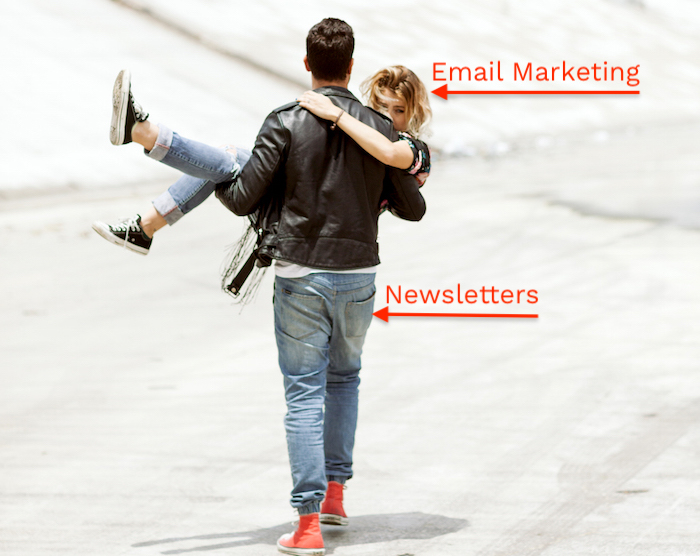by Mark Bloom | Dec 13, 2021 | Agency Advice

How Does On-Page SEO Help My Website?
Ask any nine search engine optimization (SEO) experts what’s the best tip for improving your website’s visibility online, and you may get nine different responses. From adding valuable backlinks to using appropriate long-tail keywords, all the answers you get — all those techniques — help your site get noticed. As a business owner, you can spend hundreds or even thousands of dollars every month on substantial SEO efforts.
But there’s one factor that most SEO experts agree on: once a visitor lands on your company website or landing page, it’s up to the design and the content to win them over. Once SEO has done its job and delivered traffic to your website, it’s up to your website — and your website alone — to convert that traffic into new customers. That makes your website content extremely important to your business’s success.
What Can I Do to Make My Site More Effective?
To make your business website work harder for you, optimize your website content. Also known as “on-page SEO,” this technique is completely under your control, so there’s absolutely no reason for you not to pursue this strategy. When it works, your SEO campaigns work better and you’ll likely not only attract more traffic, but you’ll also convert more of that traffic.
Improving your on-page SEO requires several tweaks to your website content. Follow these nine tips:
- Improve your on-page formatting. Use bolded and italicized text for emphasis. Ray Access uses a strategy of bolding one phrase or sentence in every paragraph on the page to help a visitor scan the page and understand the gist of the page.
- Create on-page lists. When you add either bullet lists or numbered lists, as appropriate, you not only make information easier to grasp, but you also add whitespace to the page, which alleviates eye strain. No reader wants to see a large block of text: it discourages reading. Instead, for positive on-page SEO, make every page inviting and accessible.
- Include subheadings. Break up your website pages with distinct sections, introduced by bolded subheadings. If you make each subhead a question — such as: What’s the Best Website Creation Tool? or Are Subheads Necessary? — you may even compete for Google’s Featured Snippet: which is a huge boost to your site’s SEO.
- Proofread your website content before publishing. This tip goes for your blog posts too. In fact, never publish anything to your site before you let an editor or experienced writer review it. Avoid misspellings of names, places and products. Even though many visitors scan rather than read word-for-word, missing words or bad grammar leaves a bad impression.
- Add internal links within your site. Add links from one page to another within your website. This on-page SEO technique improves the rating of each page on your site. It also connects the whole site.
- Add external links to your site. It may sound counterintuitive to link to another website from your company’s site, but as long as you don’t link to a competitor, the tactic can actually strengthen your site. Add links to external authoritative sites, which builds trust. Additionally, search engines count external links as a positive, especially if you link to an expert site, such as your industry professional association or another recognized neutral site, such as a university.
- Use effective, attractive design. Any design that looks dated dates your company. Visitors may not buy from a company whose website looks like it hasn’t been updated since 1998, especially if you’re supposed to be a modern, up-to-date company. How your site looks matters to your on-page SEO.
- Include original graphics and photographs. All graphics increase the design of your business website, but using original artwork and photography add interest. Have you ever recognized a stock photo on a website? It doesn’t stop you from continuing to read (or scan), but the stock photo may stick in your mind. How else, you may ask yourself, have they cut corners? Original artwork builds trust.
- Improve your page-loading speed. If your site takes more than three seconds to load, you have a potential problem. That delay gives would-be visitors time to click away and perhaps end up on your competitor’s website. To optimize on-page SEO, limit the size of your images. Link to videos instead of embedding them into your site. Test how fast your pages load and adjust accordingly.
You can complete all these simple on-page SEO steps by yourself, but contact Ray Access if you need help with your website content or blog. The best content communicates clearly, provides valuable information and engages your audience. That’s the kind of content Ray Access provides.
Ray Access is a content marketing firm that delivers targeted words to empower your business. Contact us about your specific project to receive a quote or discuss your needs. We write website copy, blog posts, e-newsletters and more. Everything we do is thoroughly researched, professionally edited and guaranteed original.
by Mark Bloom | Nov 15, 2021 | Small Business Advice

What Is Local Marketing?
On the internet, you can find websites for international conglomerations, major online retailers and local mom-and-pop stores. Sometimes, the difference is stark, since international businesses have the resources to create a website using the latest, fanciest technology, while small local businesses are often cash-strapped.
But even if you own a local business that has a brick-and-mortar, walk-in location, you can still use the power of the internet to market your business. Even if you want to attract just the potential customers in your region, city or neighborhood, the internet is still the best way to get your message across. The tactics are called local marketing or local SEO (search engine optimization).
In space, no one can hear you scream because it’s a vacuum.
On the internet, no one can tell the size of your company for the same reason.
How Do You Attract Your Audience?
Every store in every city used to use tried-and-true local marketing and advertising to attract customers. Some of these strategies still work: local TV and radio ads, local newspaper ads, billboards and even direct-mail flyers. With more and more people looking online for local products and services, you need a way to attract them.
Fortunately, there are effective ways to optimize your website so that your local customers can find you. Your customers’ mobile phones become a helpful asset in this attempt, for two reasons:
- Most people now use their mobile devices to search the internet
- Most phones are sensitive to the current location
What Are Local Marketing Tips and Tricks?
Just as no one knows how big your business is online unless you tell them, no one knows where you are unless you do the same. So, if you’re trying to attract local customers, let them know where you are. This is, without a doubt, the simplest trick. Modify the content on your existing website pages to include your location. For example:
- Instead of writing: “We’re a local content writing firm,” include your location: “Ray Access is a content writing firm in Asheville, NC.”
- Instead of using a generic keyword phrase like “web developer,” include the place: “web developer in Atlanta.”
This trick, if done extensively throughout your site, cements your business to a particular place, where local customers, who are searching for local businesses, can find you. Other local marketing tips include:
- Google My Business. Claim and complete your “Google My Business” listing. Besides helping locals find your business, it also contains your address, hours, ratings and reviews, photos and other business-related information. It’s free, and it works.
- Google Maps. Develop positive ratings for Google Maps. Another Google product, this one includes your business on local maps that customers use for local searching. But you need ratings that are positive and authentic to crack the Maps app. Google has to know that you’re a quality, reliable local business.
- Google Reviews. Get your existing customers to leave Google reviews. The more and better your ratings, the more Google can trust you. Then the giant search engine becomes an ally, listing your business on maps and relevant searches.
Ray Access is a content marketing firm that delivers targeted words to empower your business. Contact us about your specific project to receive a quote or discuss your needs. We write website copy, blog posts, e-newsletters and more. Everything we do is thoroughly researched, professionally edited and guaranteed original.
by Mark Bloom | Nov 2, 2021 | Small Business Advice

What Is Content Marketing?
Simply put, content marketing is using the power of your website to promote your business and gain new customers. The words you use on your website and in your social media posts comprise your content marketing strategy. This isn’t a passive endeavor; you must conduct proper keyword research to know where to focus your efforts, and you have to refresh your content on a regular basis through:
- Blogging on your website
- Posting to your social media outlets
- Tweaking the content on your website
While search engine optimization (SEO) draws visitors to your website, it’s the content on your site that makes or breaks your attempt to convert those visitors into active customers. That’s the value of content marketing, and that’s why you need to pay attention to content marketing tips. If you’re doing your own content marketing, these tips help you do it more effectively. Even if you’ve hired a firm like Ray Access, these tips help you understand the process.
How Does Content Marketing Work?
Every business has, or should have by now, a professional website. The first content marketing tip is that your chosen keywords have to be used effectively on the website, part of effective SEO. This on-page SEO, comprising the words on the page, is directly under your control.
The content on each page must be attuned to a single concept or subject. For example, if you have a web page about the best mousetrap in the world, a product you sell, that page should describe everything about your mousetrap, mousetraps in general and why yours is the most effective. If your content is understandable enough and persuasive enough, more people will buy mousetraps from you.
What Are Some Content Marketing Tips?
The following content marketing tips come in handy when you’re revising your website copy, planning your blog strategy, trying to attract more visitors to your website or attempting to make your social media posts more engaging. It’s imperative before you embark on a content marketing campaign that you fully understand your market. You should know:
- What they want from you
- What their problems are
- Where they search for answers online
After you know your audience, you can directly write to them. By writing to the specific population that make up your target audience, your content immediately becomes more engaging to them. Other content marketing tips include:
- Publish new content consistently. Every time you change your website and every time you publish a blog post on your website, you force the search engines to re-index your site. By continually adding to your website, you keep your site fresh in the eyes of those search engines, which makes your SEO more effective.
- Write about topics your audience wants to learn about. The second-most important content marketing tip is to write about the things your market wants to know. Write about news involving your industry that’s important or interesting. Provide tips about your products or services. Write about how your company can solve the problems your audience has.
- Write in the language of your audience. This tip isn’t about writing in English; it refers to writing in the tone and vernacular your audience is used to. If your market is small business owners, for instance, don’t write in stilted academic structure. Write so that your content can be easily understood.
- Use keywords appropriately. Keyword research is vital to content marketing, so you capture the same terms that your audience is searching for. Once you have the keywords, you still have to use them correctly. Don’t stuff them into your website; keep the content flowing naturally. This blog post is a prime example, since the keyword phrase, “content marketing tips,” is used properly throughout.
- Proofread before publishing. Never publish anything on your website until you’ve had it reviewed or edited. Nothing ruins your reputation more quickly than misspellings or awkward grammatical mistakes. Keep your content error-free and clear by having it proofread.
- Don’t forget mobile devices. While it’s common knowledge that your website has to be mobile-friendly, content marketing tips wouldn’t be complete if they left out the requirement to make your blog posts and social media posts fit for mobile devices. That translates to short sentences and paragraphs. Make your point concisely.
These content marketing tips are meant to help you increase your SEO and generate more online leads: those visitors who become your customers. If you need help improving your website content or blog posts, contact Ray Access for expert assistance.
Ray Access is a content marketing firm that delivers targeted words to empower your business. Contact us about your specific project to receive a quote or discuss your needs. We write website copy, blog posts, e-newsletters and more. Everything we do is thoroughly researched, professionally edited and guaranteed original.
by Mark Bloom | Oct 4, 2021 | Small Business Advice

What Is a Persona?
A persona, as we’ve described before, is a conglomeration of your target audience, a personification of your ideal client or customer. Creating a persona is an exercise in examining and defining your audience so you better understand what they want and need, so you can tailor your message to them.
You can actually create multiple personas for your business or agency if you have several different target markets. For example, Ray Access serves both individual businesses and online agencies with many clients. The number of personas you may need depend on who your customers are.
How Can I Use a Persona?
To really use a persona that you’ve developed, you need to spend time trying to understand what your audience wants and needs. It’s not enough to know that your target market may want to buy your products or services; you have to understand why. Does your work make their lives easier? Does it help them achieve a goal? Does it offer something they don’t have or can’t do on their own? You have to know.
You also need to be able to speak and write in a way that your audience can easily grasp. For example, writing for an aging population is very different than writing for mostly twenty-somethings. Besides the language you employ in your messaging, which helps attract your audience, you must make your message engaging. To use a persona, you must write to that individual.
How Does a Persona Help Me Focus My Message?
You can use a persona to refine the messaging to your customers in a number of ways. The best way to start is to add as much detail to your persona(s) as possible. Give your persona a gender, an occupation, a salary, hobbies, a family size and even a name. Find a stock photo that captures this fictional person.
To craft your message, write directly to that person. The more detail, the better. Don’t write to a 30-something housewife who needs a pocket organizer. Instead, write to Molly, who’s 33, lives in a three-bedroom home with her husband Bobby and her two kids Scott and Jennifer. She struggles to keep up with the kids’ activities while working as a manager of a craft store.
Now you’re writing with a specific person in mind. You can even use Molly’s name in your message, as if you’re speaking to her. (You can always remove her name later.) Do whatever it takes to address Molly’s specific needs and wants, while staying true to your brand.
Can I Test My Message?
If you want to get creative, take your message outside the office. Try something radical, such as:
- The elevator pitch test. In a skyscraper, ride up and down on the elevator until you meet someone who resembles your persona. Strike up a conversation and give the opening of your message. Does it attract their attention for the 15 to 30 seconds you have between floors? If it’s not strong enough to gain at least a raised eyebrow, go back to the drawing board and make the opening lines captivating.
- The lunch stool test. Wait at a popular diner or restaurant until you see someone resembling your persona sit at the counter. Sit down on the next stool and engage politely. Can your message maintain the person’s interest? Craft your message to be sharp, concise and engaging throughout.
- The street interview test. Get out onto the street with a fake microphone. Stop people resembling your persona and ask several questions and then share your message. Does the person stay? For how long? This is a way to gauge the length of your message. Too long and it becomes boring. Too short, and it’s not engaging enough.
Use a persona to fine-tune your messaging so that it’s targeted, concise and compelling from start to finish. Make sure you play the same message to all your personas, or create different messaging for each of the personas you’ve created.
If you’re having trouble creating your message to appeal to your persona, Ray Access can help. Contact us to write messaging that’s targeted to your audience. Count on Ray Access for the most effective content — for your website, blog or newsletter.
Ray Access is a content marketing firm that delivers targeted words to empower your business. Contact us about your specific project to receive a quote or discuss your needs. We write website copy, blog posts, e-newsletters and more. Everything we do is thoroughly researched, professionally edited and guaranteed original.
by Mark Bloom | Sep 20, 2021 | Small Business Advice

Partnerships Can Work for Your Small Business
There is no such thing as a solo entrepreneur. Nobody who’s ever scaled a business from the ground up did it alone. In fact, left to themselves, they wouldn’t have a business. That’s why having a business partner is the best business idea ever. Partnerships can work, and if you click with your partner, you’ll egg each other on to greater heights than either of you could manage alone. A few of the benefits include:
- Backing each other up
- Covering for one another
- Sharing the duties, so you’re not stretched thin
- Reminding each other why you do what you do
The most common reason startups fail is because management or ownership burned out. You can’t do it all on your own, and yet many startup owners feel like they have to. It works until it doesn’t. With a partner, you can get twice as far before you have to start delegating or hiring — whatever taking that next step looks like for your business. There are many other reasons that partnerships work, especially when you begin and then follow a solid, mutual path.
1. Start with Commitment
In a partnership, each person has to have the same level of commitment. If one person feels like he or she is doing more than the other, resentment kicks in, which can spell doom for the business. This happens more often than not, and most partnerships can’t overcome it.
But there are ways around this almost inevitable problem, including:
- Communicate constantly about the workload and the shared responsibilities. It’s up to each of you to encourage the other. It’s about reaching beyond what one of you can accomplish.
- Meet regularly. Outline the duties you each have. Partnerships can work when you talk face-to-face on a regular basis. Email or even Zoom isn’t enough.
- Write down your duties. When you see on paper what each of you is doing or has to do, often resentment dissolves. You don’t have time to keep checking on your partner, but when you know what you’re both doing, you can focus on the work you have to do to keep up.
2. Respect Each Other
You usually know what you’re good at doing. Find out what your partner brings to the table. If your strengths are both the same, you may be in trouble. Partnerships can work better when you both excel at different aspects of the business.
When you learn to respect the abilities of your partner, you believe your partnership can work. That belief can pull you through the inevitable days when things don’t seem so rosy. Other benefits of respecting each other include:
- Trusting that your partner will complete the ongoing duties or the tasks assigned.
- Knowing that problems will be aired early, when there’s time to resolve them.
- Appreciating the work your partner does, but being able to offer constructive feedback that makes you both better.
3. Make Everything Unanimous
Partnerships can work best when you both agree on everything. In the real world, that rarely happens, but when you’re able to communicate with each other, you can both make your arguments without it devolving into an ego fight. You both understand that it’s not about who wins; it’s about helping the business win.
The way you handle disagreements between you and your partner goes a long way in informing you how you’ll both handle adversity. Some tips for resolving internal conflict include:
- Listen, listen, listen to your partner’s argument.
- Think big picture. Which idea truly helps the business more?
- Be willing to let go of your idea if your partner’s starts to make more sense.
- Don’t lose sight of your goals when you’re digging in the weeds.
4. Plan to Succeed; Be Ready to Forgive
When you form the partnership, you obviously want the company to succeed. The division of labor makes life easier. The shared responsibilities mean you both can get more done. The extra resources you both bring to the table can give your business a boost when it needs it most.
But not all plans come to pass. Not every person is perfect. Your partnerships can work when you’re on the same team. If one person makes a mistake, be ready to forgive. Mistakes will happen, and no one makes them on purpose. It may be your turn next. It’s not who’s right and who’s wrong, but who needs support in the moment. Remember:
- When you stick together, you’re twice as strong.
- When one partner makes a mistake with a client or employee, the other person can step in, if needed.
- Like parents, a united front gives the company an authoritative appearance.
5. Make It Legal
A partnership agreement — a legal document that seals your partnership and includes an exit plan — puts in writing everything you expect the partnership to do and to be. It’s your chance to make sure it’s all in writing, duly signed, witnessed and notarized. It’s the basis for your legal formation of the company.
You can still make changes to it later, assuming you both agree, but setting the partnership to paper creates a powerful bond between the two of you. It gives you meaning and may even set out your goals for the business. And it’s a great starting point so partnerships can work.
Ray Access is a partnership. A company founded by El Ray and Mark Bloom, it has flourished over the years. And it’s due to all these factors. Partnerships can work if you put work into your partnerships. Good luck!
Ray Access is a content marketing firm that delivers targeted words to empower your business. Contact us about your specific project to receive a quote or discuss your needs. We write website copy, blog posts, e-newsletters and more. Everything we do is thoroughly researched, professionally edited and guaranteed original.
by Mark Bloom | Sep 7, 2021 | Communication

Aren’t Words Serious?
The writers and editors at Ray Access take words — and writing — seriously. After all, clients pay for the words produced. But all work and no play make for pretty dull writing. When words collide is a playful way of saying that words can also entertain, sometimes on purpose and sometimes by accident.
As summer turns to autumn, let’s not forget that life can be fun when words collide. Whether it’s a poor translation or a purposeful slip of the tongue, words used incorrectly can put a smile on your face. Here are some examples, attributed when the author is known:
What Happens When Words Collide?
In a London department store: “Bargain Basement Upstairs.”
In an office: “Would the person who took the step ladder yesterday please bring it back … or further steps will be taken.”
In an office: “After tea break, staff should empty the teapot and stand upside down on the draining board.”
In a safari park: “Elephants please! Stay in your car.”
At a conference: “For anyone who has children and doesn’t know it, there is a day care on the 1st floor.”

At a newspaper office: “A gossip is someone with a great sense of rumor.”
At a library: “The man who does not read good books has no advantage over the man who can’t read them.” (Mark Twain)
On a country gate: “The farmer allows walkers to cross the field for free, but the bull charges.”
At a place of worship: “We are here on earth to do good unto others. What the others are here for, I have no idea.” (W.H. Auden)
At a math conference: “The generation of random numbers is too important to leave to chance.”
On a bumper: “My mother is a travel agent for guilt trips.”
In an employment office: “Tell your boss what you really think about him and the truth shall set you free.”
At a comedy club: “He who laughs, lasts.” (Wilfred Peterson)
On a T-shirt: “Whenever I feel blue, I start breathing again.”
At the City Clerk’s office: “Love may be blind, but marriage is a real eye-opener.”
At a factory: “The man who fell into an upholstery machine is fully recovered.”
On a car being pulled by an RV: “I go where I’m towed.”
In an optometrist’s office: “If you don’t see what you’re looking for, you’re in the right place.”
In a psychiatrist’s office: “The only normal people are the ones you don’t know very well.” (Alfred Adler)
From a business coach: “A pessimist complains about the noise when opportunity knocks.”
On a leaflet: “If you can’t read, this leaflet will tell you how to get lessons.”
At Ray Access: “Quoting one is plagiarism; quoting many is research.”

The writers and editors at Ray Access hope you’ve enjoyed this brief detour from the business of writing. While we take words seriously for our clients, when words collide, the outcome can be unintentionally comical. When you need your words to be perfectly clear and on target, contact us.
Ray Access is a content marketing firm that delivers targeted words to empower your business. Contact us about your specific project to receive a quote or discuss your needs. We write website copy, blog posts, e-newsletters and more. Everything we do is thoroughly researched, professionally edited and guaranteed original.
by Mark Bloom | Aug 23, 2021 | Small Business Advice

Does Creating a Persona for Business Help or Hinder?
To learn more about your audience or target market, you can create polls, hold contests or monitor social media. You can also create a persona, a fabricated character who embodies the most common aspects of your customers. A persona helps you better understand your customers, which in turn helps you better serve their needs.
Admittedly, creating a persona for business takes some time and effort. Is creating a persona worth the effort? The answer depends on how you use it. Once completed, you can leverage your persona — or personas, since you may have multiple customer types — in a number of business-related activities, including:
- Creating targeted content for your website, blog and social media
- Building successful advertising and marketing campaigns
- Redesigning your products and services to better meet your customers’ needs
Whether you’re a solopreneur or a large corporation, developing personas for your business can help you succeed by outmaneuvering your competition and better serving your market. In fact, it can become an ongoing exercise, or at least a task you return to again and again, to check in with your customers to make sure you’re still offering the most appropriate goods and services.
How Do I Start Building a Persona?
The first step toward a persona is confirming basic information about your customer set or sets. For example, Ray Access has two primary customers to serve:
- Individual businesses, including business owners and marketing directors
- Online agencies, such as web developers and SEO firms who need content for their clients
You must identify the customer sets you serve. Are you selling to online retail companies who want to increase their marketing presence? Maybe you serve growing businesses that need a simple solution for payroll. Whatever your market, you need to define it. Then you can begin collecting the information that will confirm your market … or point you in a whole new direction.
What Information Does a Persona for Business Require?
You don’t need complicated or expensive software to start the process of developing a persona for business. A spreadsheet will suffice. But you have to know which information to collect or record for all your customers. And for any information that you don’t know, you must discover. Start with some basic information, such as:
- Geographic location (city and state)
- Gender and age, if relevant
- Income level and education
- Job title with their company
- Outstanding problems they have to solve
- Company goals when buying from your business
- Where they search for answers, including search engines, social media, competitor websites, print material or conferences
- How much each customer spends with your company and how often they return
Make sure to include this information from all your existing customers, but you may be able to get some of this data from prospective customers, such as those who’ve visited your website or signed up for your newsletter. The more information you collect, the more specific (and the more useful) your persona for business becomes. This step requires some effort.
How Do I Build My Persona?
Collecting the information is the most time-intensive part of building a persona. You can get some of this data from your website analytics and past interactions with your customers. To get more information, you may need to come up with a short list of pointed questions, and then send them (by email or better, by phone) to your past customers.
Then comes the fun part: building a persona for business. You can follow several steps to complete your persona, including:
- Gather aggregated data and come up with an average for each category. For example, where are most of your customers located?
- List each point to build a character. For example: write down the average age, income level, job title, gender and home of your average customer.
- Give your persona a name, such as: George or Wendy.
- Find a photo that approximates what your persona may actually look like.
- Put it all together in a large format that you can hang on the wall. The photo and peripheral information give you and your team an image of the exact person you’re trying to reach.
How Do I Use My Persona for Business?
Your team can now imagine your persona when creating content and marketing. How they reach your persona is the key to the whole exercise, but knowing whom you’re trying to attract can streamline your content creation. You’re writing to a specific person, instead of an amorphous “market.”
At Ray Access, the writers and editors believe in finding the market you’re trying to reach. A persona for business helps define the audience. They don’t start writing until they know who they’re writing for. You should do the same.
Ray Access is a content marketing firm that delivers targeted words to empower your business. Contact us about your specific project to receive a quote or discuss your needs. We write website copy, blog posts, e-newsletters and more. Everything we do is thoroughly researched, professionally edited and guaranteed original.
by Mark Bloom | Aug 9, 2021 | Small Business Advice

What Is Email Marketing?
Email marketing’s been in the news a lot lately, but what is it exactly? Consider those direct mail flyers and envelopes that appear in your mailbox every week. Sometimes, they offer coupons. Sometimes, they announce new products, services or locations. These mailers are marketing pieces, and they’re effective. Even if you don’t act on them, you often remember the company names, even if you don’t mean to.
Email marketing works the same way, but with two very important differences:
- Your marketing words are delivered directly to your customers’ email inboxes, instead of their external mailboxes.
- You don’t need to worry about printing costs, although you do often need a web-based service, such as MailChimp or Constant Contact — just two names of many options.
Email marketing, like direct marketing, allows you to send coupons from your business, announce new products, services or locations. You can also use email marketing to share news of your industry. Like blog posts, email marketing pieces can provide tips for better using your products or services. And like all online content, you can use an email marketing specialist to produce effective content.
How Do Newsletters and Email Marketing Work Together?
Newsletters for businesses act as vehicles for email marketing. You can deliver them once a month or as often as twice a month to your email list. Sending a newsletter:
- Keeps your business brand top of mind
- Reminds your customers of your value and quality
- Shares your latest deals and offers
- Delivers useful and valuable information
Newsletters for agencies may have a dual purpose. If you run an internet agency, you can use a newsletter to grow your own business, but you can also offer email marketing services to your clients. It’s another service to help your clients succeed.
Using a professional email marketing specialist takes care of the details for you, including the content creation, the email list management and the delivery process. While you still get the opportunity to approve all content, including the newsletter design, before it gets sent, you don’t have to worry about the details. An email marketing specialist like Ray Access handles it all.
What Do I Need to Start a Newsletter?
The first and most important requirement for a newsletter is a list of email addresses of your clients and prospective clients. Acquiring email addresses is an art and a science. Perhaps the best way, after gathering the email addresses of all your clients, past and present, is to offer something of value on your website that your visitors have to sign up to get, leaving — you guessed it — their email address.
In addition to an email list, you need to either hire an email marketing specialist or buy a membership in an email marketing service that can send out hundreds or thousands of emails at the same time. You need to design a template on that service and then populate it with content however often you plan to send your newsletter.
Interested in starting a newsletter for your business or agency? Contact Ray Access, an email marketing specialist who makes it happen for you. Need more information about email marketing or newsletter? Read some of our other blog posts, including:
Ray Access is a content marketing firm that delivers targeted words to empower your business. Contact us about your specific project to receive a quote or discuss your needs. We write website copy, blog posts, e-newsletters and more. Everything we do is thoroughly researched, professionally edited and guaranteed original.
by Mark Bloom | Jul 26, 2021 | Agency Advice
What Can Good Writers Do for My Business?
Having a writer on your team who knows how to navigate the business environment can be a huge asset to your company. In fact, a good writer can save your business in more than one way. No matter how good your products or services are, you need a writer to:
- Promote your goods and services
- Connect with your target audience
- Make search engines take notice of your website
- Help potential customers find your business online
- Protect your company’s online reputation

So then the question becomes how to find good writers. You can find writers in every city, town and hamlet. You can find writers by the score online with a simple search engine search. But how to find good writers remains a problem for businesses that want to hire or contract them.
Want to Learn How to Find Good Writers?
While finding writers is no problem, vetting them is. But there are answers to this dilemma. When you’re ready to learn how to find good writers for your business, listen to your friends at Ray Access and employ tips that include:
- Review the writer’s portfolio, including not just quality, but specialties and breadth of work
- Interview the writer to ask pointed questions about process, favorite accomplishments and research techniques
- Ask for references and follow up on them
- Find out if the writer uses a style guide or can write in different styles, depending on need
- Ask about the length of time required to complete an average project
To find a writer who matches your business needs, you have to do your due diligence. Even after a writer satisfactorily answers the questions above, and you move forward to hire or contract, you must stay vigilant to ensure that the content the writer produces continues to meet your standards. Don’t let your writers get lazy or sloppy.
How Else Can I Ensure a Business Writer Meets My Needs?
It’s one thing to know how to find good writers; it’s another to actually find out if they’re right for you and your business. Ray Access as a business is always on the lookout for good writers to add to the team. Once a writer agrees to our terms, he or she is given a test assignment, usually a short blog for a client.
This is a paid assignment because the principals of Ray Access believe that no writer should work for free, and the point of this exercise is to actually produce something useful. If the writer shows enough promise, other assignments will follow. Otherwise, the writer’s paid for the work and told to find work elsewhere.
How Do I Keep Writers Delivering Quality Work?
A test assignment is part of the process for onboarding a new writer, but even after the writer is accepted into the position, the principals and editors expect to coach the new writer through at least several assignments. Coaching takes several forms, including sending:
- The article back with notes for a rewrite
- Constructive criticism of completed work
- The edited version of the article back to the writer to compare
- Occasional general tips to stop commonly seen issues
If writers continue to make improvements, Ray Access continues to work with them. Plagiarism is grounds for immediate dismissal, but if the quality slips badly or no progress is observed, the writer is warned and then dismissed.
Deadlines are extremely important to the editors at Ray Access, as they are to you. Missing deadlines without prior notice is as a dismissible offense. It’s a balancing act, but the ultimate goal is to have a team of writers delivering good quality work. If you’re not sure how to find good writers, contact Ray Access.
Ray Access is a content marketing firm that delivers targeted words to empower your business. Contact us about your specific project to receive a quote or discuss your needs. We write website copy, blog posts, e-newsletters and more. Everything we do is thoroughly researched, professionally edited and guaranteed original.










